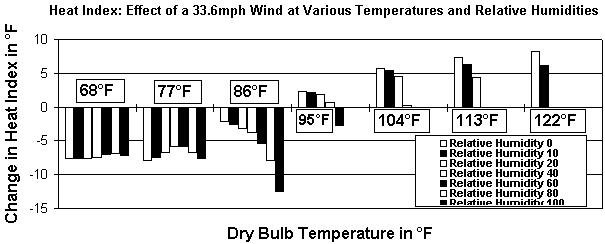|
This concept is even more powerfully conveyed graphically. In this chart, bars below
the line represent wind-caused Heat Index lowering, bars above the line represent
wind-caused Heat Index elevation. Each bar is a different relative humidity, with
relative humidity rising from left to right for each temperature cluster.

For example, at an air temperature of 95°F, with a relative humidity of 40%, a 33.6 mph
wind makes the Heat Index 0.7°F warmer than it would be with a gentle breeze of 5.6mph.
It must be remembered that this chart refers to the effects of a high wind, 33.6mph,
which according to the Beaufort scale of wind is properly termed a "moderate
gale". Lesser winds will have proportionately smaller effects.
Here is what can be said of the effect of wind on Heat Index, the way that the air
"feels":
- The effect of wind cannot be accurately determined unless the air temperature and
relative humidity are also known.
- At high temperatures (95°F and above) with low relative humidities (less than 40%),
wind tends to produce worsening of heat stress on the athlete. (The vast majority of
temperatures ³ 95°F are associated with relative
humidity £ 40%.)
- Even a "moderate gale" usually produces fairly limited effects, a 2° to 7°F
change, and lesser winds have proportionately less effect on heat stress.
An anecdote to illustrate this concept: Every year
in late August, Wichita Falls, Texas, plays host to the Hotter 'n Hell Hundred Bicycle
Ride. Since the inception of this race in 1982, more than 120,000 riders have participated
in what has become the largest sanctioned 100-mile bicycle race in the US. Wet Bulb Globe
Temperature usually averages above 85°F, placing a great deal of heat stress on the
riders. In 1994, 1800 riders were unable to finish the race and were assisted back to the
starting line area in "sag wagons". Even riders who are well-conditioned and
have recently finished a hundred mile race may succumb to the heat. Race Medical Director
Dr. Larry Magruder says of the heat casualties, "The most consistent predictor of
heat injury is wind, not heat. The years with the wind speed greater than 20 mph see the
most heat-related injuries, not the years with the highest WBGT."
Next Page.
|
